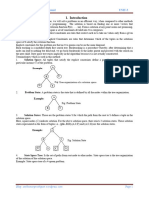0% found this document useful (0 votes)
14 views18 pagesBacktracking
The document discusses backtracking as a problem-solving strategy for finding solutions that meet certain constraints, using bounding functions and n-tuples. It provides examples such as the sum of subsets problem and the n-queens problem, illustrating how to represent solutions and the constraints involved. Additionally, it touches on related problems like graph coloring and Hamiltonian cycles, emphasizing the organization of solution spaces and the process of backtracking to find valid solutions.
Uploaded by
mr.random1812Copyright
© © All Rights Reserved
We take content rights seriously. If you suspect this is your content, claim it here.
Available Formats
Download as PDF, TXT or read online on Scribd
0% found this document useful (0 votes)
14 views18 pagesBacktracking
The document discusses backtracking as a problem-solving strategy for finding solutions that meet certain constraints, using bounding functions and n-tuples. It provides examples such as the sum of subsets problem and the n-queens problem, illustrating how to represent solutions and the constraints involved. Additionally, it touches on related problems like graph coloring and Hamiltonian cycles, emphasizing the organization of solution spaces and the process of backtracking to find valid solutions.
Uploaded by
mr.random1812Copyright
© © All Rights Reserved
We take content rights seriously. If you suspect this is your content, claim it here.
Available Formats
Download as PDF, TXT or read online on Scribd
/ 18
























































































